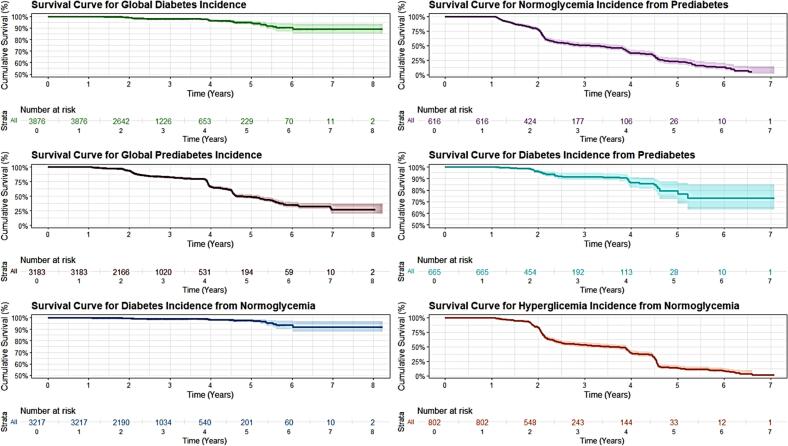Incidence rates of prediabetes and diabetes associated with sedentary behavior and night shifts among peruvian workers (2014–2021)
引用次数: 0
Abstract
Introduction
Type 2 diabetes mellitus (T2DM) and prediabetes represent a global public health concern, with increasing prevalence in developing countries. Occupational factors such as sedentary behavior and night shift work may play a significant role in their development; however, there is limited information on their impact on Latin American populations.
Objectives
To determine the incidence of T2DM and prediabetes and to evaluate the association between prolonged sitting time and night shift work with glycemic changes in Peruvian workers.
Methods
A retrospective cohort study was conducted with 4200 workers evaluated between 2014 and 2021. Incidence rates of T2DM and prediabetes were calculated, and Cox regression models were used to assess the association between prolonged sitting time and night shift work with glycemic changes. The measure of association was the crude and adjusted hazard ratio (aHR), presented with its respective 95 % confidence interval (95 % CI).
Results
The incidence of T2DM was 33.1 per 1000 person-years, and that of prediabetes was 77.11 per 1000 person-years. Sitting time (≥ 4 h/day) was associated with a higher hazard of diabetes (aHR: 2.84, 95 % CI: 1.58–5.12). Night shift work also significantly increased the hazard of diabetes (aHR: 3.24, 95 % CI: 1.97–5.35).
Conclusion
This study reveals a high incidence of T2DM and prediabetes among Peruvian workers, with significant associations between prolonged sitting time and night shift work with glycemic changes. The results underscore the importance of considering these occupational factors in T2DM prevention strategies. Implementing workplace prevention and early detection programs focused on reducing sedentary time and mitigating the effects of night shift work is recommended.

2014-2021年秘鲁工人中与久坐行为和夜班相关的前驱糖尿病和糖尿病发病率
2型糖尿病(T2DM)和前驱糖尿病是一个全球性的公共卫生问题,在发展中国家发病率越来越高。职业因素,如久坐行为和夜班工作可能在其发展中发挥重要作用;但是,关于它们对拉丁美洲人口的影响的资料有限。目的:确定2型糖尿病和前驱糖尿病的发病率,并评估秘鲁工人长时间坐着和夜班工作与血糖变化之间的关系。方法:对2014年至2021年间4200名工人进行回顾性队列研究。计算T2DM和前驱糖尿病的发病率,并使用Cox回归模型评估长时间坐着和夜班工作与血糖变化之间的关系。相关性的测量是粗风险比和调整风险比(aHR),分别以其95%置信区间(95% CI)表示。结果:T2DM发病率为33.1 / 1000人-年,糖尿病前期发病率为77.11 / 1000人-年。静坐时间(≥4小时/天)与糖尿病的高风险相关(aHR: 2.84, 95% CI: 1.58-5.12)。夜班工作也显著增加患糖尿病的风险(aHR: 3.24, 95% CI: 1.97-5.35)。结论:本研究揭示了秘鲁工人中T2DM和前驱糖尿病的高发,长时间坐着和夜班工作与血糖变化之间存在显著关联。结果强调了在T2DM预防策略中考虑这些职业因素的重要性。建议实施工作场所预防和早期检测计划,重点是减少久坐时间和减轻夜班工作的影响。
本文章由计算机程序翻译,如有差异,请以英文原文为准。
求助全文
约1分钟内获得全文
求助全文
来源期刊

Dialogues in health
Public Health and Health Policy
CiteScore
0.70
自引率
0.00%
发文量
0
审稿时长
134 days
 求助内容:
求助内容: 应助结果提醒方式:
应助结果提醒方式:


